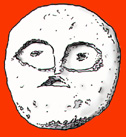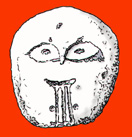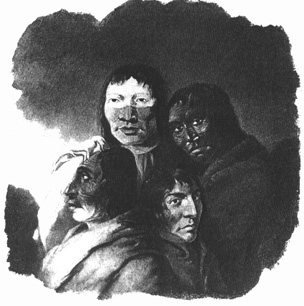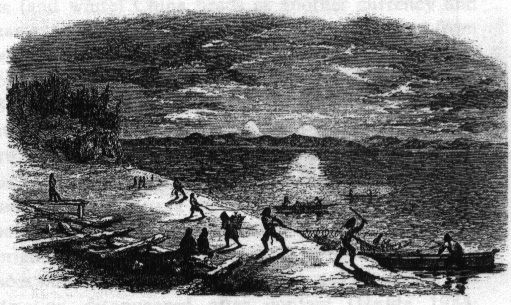...on the North side of the columbia a little above the entrance of this inlet a considerable river discharges itself. this stream the natives call Cah-wah-na-hi-ooks. it is 150 yards wide and at present discharges a large body of water, tho'from the information of the same people it is not navigable but a short distance in consequence of falls and rappids a tribe called the Hul-lu-et-tell reside on this river above it's entr.- at the distance of three miles above the entrance of the inlet on the N. side behind the lower point of an island we arrived at the village of the Cath [X: Quath]-la-poh-tle wich consists of 14 large wooden houses. here we arrived at 3 P.M. the language of these people as well as those on the inlet and wappetoe Island differs in some measure from the nations on the lower part of the river. tho' many of the words are the same, and a great many others with the difference only of accent. the form of their houses and dress of the men, manner of living habits custom &c as far as we could discover are the same.
their women wear their ornaments robes and hair as those do below tho' [NB: Indian women on Wappato Island & in that Valey] here their hair is more frequently braded in two tresses and hang over each ear in front of the body. in stead of the tissue of bark woarn by the women below, they wear a kind of leather breech clout about the width of a common pocket handkerchief and reather long. the two corners of this at one of the narrow ends are confined in front just above the hips; the other end is then brought between the legs, compressed into a narrow foalding bundel is drawn tight and the corners a little spread in front and tucked at the groin over and arround the part first confind about the waist. the small robe which dose not reach the waist is their usual and only garment commonly woarn be side that just mentioned. when the weather is a little warm this robe is thrown aside and the leather truss or breech-clout constitutes the whole of their apparel. this is a much more indecent article than the tissue of bark, and bearly covers the mons venes, to which it is drawn so close that the whole shape is plainly perceived.
the floors of most of their houses are on level with the surface of the earth tho' some of them are sunk two or 3 feet beneath. the internal arrangement of their houses is the same with those of the nations below. they are also fond of sculpture. various figures are carved and painted on the peices which support the center of the roof, about their doors and beads. they had large quantities of dried Anchovies strung on small sticks by the gills and others which had been first dryed in this manner, were now arranged in large sheets with strings of bark and hung suspended by poles in the roofs of their houses; they had also an abundance of sturgeon and wappatoe; the latter they take in great quantities from the neighbouring bonds, which are numerous and extensive in the river bottoms and islands. the wappetoe furnishes the principal article of traffic with thesepeople which they dispose of to the nations below in exchange for beads cloth and various articles. the natives of the Sea coast and lower part of the river will dispose of their most valuable articles to obtain this root.
they have a number of large symeters (scimitars, or swords) of Iron from 3 to 4 feet long which hang by the heads of their beads; the blade of this weapon is thickest in the center tho' thin even there. all it's edges are sharp and it's greatest width which is about 9 inches from the point is about 4 inches. the form is thus. this is a formidable weapon. they have heavy bludgeons of wood made in the same form nearly which I presume they used for the same purpose before they obtained metal. we purchased a considerable quantitiy of wappetoe, 12 dogs, and 2 Sea otter skins of these people.
they were very hospitable and gave us anchovies and wappetoe to eat. notwithstanding their hospitality if it deserves that appellation, they are great begers, for we had scarcely finished our repast on the wappetoe and Anchovies which they voluntarily sat before us before they began to beg. we gave them some small articles as is our custom on those occasions with which they seemed perfectly satisfyed. we gave the 1st Cheif a small medal, which he soon transfered to his wife. after remaining at this place 2 hours we set out & continued our rout between this island, which we now call Cath-lah-poh-tle after the nation, and the Lard shore. at the distance of 2 miles we encamped in a small prarie on the main shore, having traveled 19 miles by estimate...
(Moulton 1990[7]:26-29)
After wintering on
the coast, Lewis and Clark turned back for the East. On March 29, 1806, William Clark described the second encounter with Cathlapotle Village and the Chinookan inhabitants:
...we
proceeded on to the lower point ofthe Said island accompanied by the 3 Indians, & were met by 2 canoes of nativs of the quath-lah-pah-tal who informed us that the chanel to the N E of the Island was the proper one. we prosued their advice and Crossed into the mouth of the Chah-wah-na-hi-ooks River which is about 200 yards wide and a great portion of water into the columbia at this time it being high. The indians inform us that this river is crouded with rapids after Some distance up it. Several tribes of the Hul-lu-et-tell Nation reside on this river. at 3 oClock P. M. we arrived at the Quath lah pah tle Village of 14 Houses on main Shore to the N E. Side of a large island. those people in their habits manners Customs and language differ but little from those of the Clatsops and others below. here we exchanged our deer Skins killed yesterday for dogs, and purchased others to the Number of 12 for provisions for the party, as the deer flesh is too poore for the Men to Subsist on and work as hard as necessary. I also purchased a Sea Otter robe.
we purchased wappatoe and Some pashaquar roots. gave a Medal of the Small Size to the principal Chief, and at 5 oCclock reembarked and proceeded up on
the N E. of an Island to an inlet about 1 mile above the village and encamped on a butifull grassy plac, where the nativs make a portage of their Canoes and Wappato roots to and from a large pond at a short distance. in this pond the nativs inform us they Collect great quantities of wappato, which the womin collect by getting into the water, Sometimes to their necks holding by a Small canoe and with their feet loosen the wappato or bulb of the root from the bottom from the Fibers, and it imedeately rises to the top of the water. they collect & throw them into the Canoe, those deep roots are the largest and best roots. Great numbers of the whistling swan, Gees and Ducks in the Ponds. Soon after we landed 3 of the nativs came up with wappato to sell a part of which we purchased...
(Moulton 1990[7]:30)
Slightly modified FROM:
Archaeological Investigations (1991-1996) at 45Cl1 (Cathlapotle), Clark County, Washington. A Preliminary Report.
by Kenneth M. Ames, Cameron M.
Smith, William L. Cornett and Elizabeth A. Sobel.
January 1999 Wapato Valley Archaeology Project Report #6.
Department of Anthropology
Portland
State University & U.S. Fish and Wildlife Service.
Click HERE for an online version of this report (including bibliographic references).





